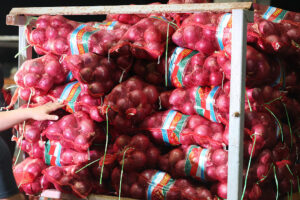By Justine Irish D. Tabile, Reporter
THE Department of Agriculture (DA) said on Wednesday that it is planning to set a maximum suggested retail price (MSRP) for other imported food commodities, expanding on the MSRP scheme for imported rice, which is expected to launch by the end of the month.
Agriculture Secretary Francisco P. Tiu Laurel, Jr. said: “Imported rice is just the beginning. We plan to cast the price net wider to include other imported food commodities like vegetables and meat.”
In a statement, the DA said it is working with the Department of Trade and Industry (DTI) to explore ways to alleviate the financial burden on consumers.
Trade Secretary Ma. Cristina A. Roque said she will soon convene the National Price Coordinating Council to review strategies for stabilizing food prices.
“We aim to strike a balance between business sustainability and consumer protection … We want the public to know that we are leaving no stone unturned in our efforts to ease the burden on consumers,” Ms. Roque said.
According to the DA, it and the DTI are in the process of determining an MSRP for rice with the goal of allowing rice importers and retailers to operate profitably without subjecting consumers to excessively high prices.
Meanwhile, the DA said that it is also considering the declaration of a national food security emergency, which would grant the Secretary the authority to release rice stocks held in reserve by the National Food Authority, helping to increase supply and bring down retail prices.
On DTI’s part, it said that it will review the prevailing regulations governing the sale and labeling of manufactured goods and adapt them to agricultural commodities.
The Secretaries have agreed to draft and sign a memorandum of understanding to expedite efforts to address the persistently high price of rice and, eventually, other essential commodities, the DA said.
“By tackling both supply and pricing issues, the government aims to stabilize the rice market and make it more affordable for consumers nationwide,” it added.
In a separate statement, the Philippine Competition Commission (PCC) said it is exploring possible collaboration with the DA to address anti-competitive practices in agricultural.
“The discussion focused on tackling issues such as price fixing, abuses of dominant market position, and the smuggling of agricultural products, which undermine competition and can lead to higher prices,” the PCC said.
“The dialogue marked an important step in enhancing collaboration between the two agencies as they work towards safeguarding the interests of farmers, fisherfolk, and consumers,” it added.
“Through this collaborative approach, the PCC and DA aim to foster a competitive market environment that benefits all stakeholders in the agricultural sector,” the PCC said.
In a briefing on Wednesday, Agriculture Assistant Secretary and Spokesperson Arnel V. de Mesa said that rice imports amounted to 4.68 million metric tons (MMT) in 2024, up from 3.8 MMT a year earlier.
“Since the tariffs are now lower along with our efforts to combat smuggling, we have reduced the incentive to smuggle,” he added.
He said the import levels could reflect the limited supply of smuggled rice.
For 2025, he said imports will depend on how domestic producers perform.
“We are hoping and we are still expecting that the rice sub-sector can recover this year because there’s no El Niño and the rain that we’re experiencing in the first part of the year because of La Niña is beneficial for our dams and for the areas that need water,” he said.
“We are still hoping that our production will be good, and if it is good, and that will correspondingly reduce the volume of imports later on. But it is still early to tell,” he added.
For 2025, the DA projects domestic rice production to return to the 20 million metric-ton level.
